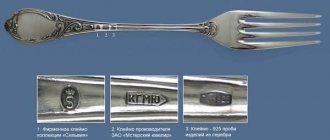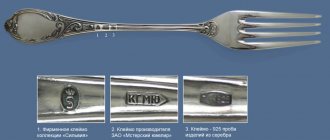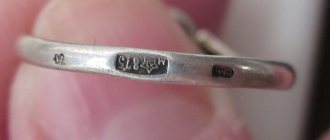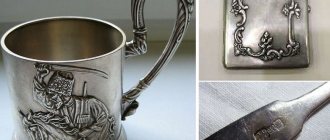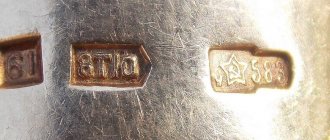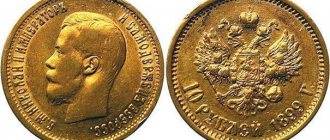The first stamps in Tsarist Russia
In Russia, the need to use stamps arose as soon as the first porcelain factories were opened. Until the mid-eighteenth century, Russia could only dream of its own porcelain production, until the incredible hard work of Dmitry Ivanovich Vinogradov at the country's first porcelain manufactory led to the discovery of a recipe for Russian porcelain. In 1747-1749, the first successful products appeared, which began to be branded with the letter W (the initial letter of Vinogradov’s surname) and the year of manufacture of the product.
There were no standards yet for the first brands, so they differed from each other in size, location and style of signs. Even then, the tradition of indicating in the mark the place of production and the recipe number of the porcelain mass began to emerge.
With the transformation of the Nevskaya Porcelain Manufactory into the Imperial Porcelain Factory, the opening of the F.Ya. Gardner and other enterprises, hallmarks helped distinguish one porcelain product from another. Moreover, enterprising people not only began to open their own porcelain establishments en masse, but also actively created counterfeits of products from well-known factories, which led to the need to create high-quality stamps.
The problem began to become widespread not only within the country, as the need arose to distinguish Russian porcelain from foreign ones. To this end, several decrees were issued at different times describing the procedure for branding porcelain products. In particular, decrees issued from the mid-18th to the mid-19th centuries ordered that the owner of the factory and its location be identified in the brands. At the same time, the product had to have a Russian mark on it, even if another mark was supposed to be for foreign markets. Since 1857, stamps had to be applied using red paint.
All these requirements left a significant imprint on the marks of Russian porcelain, although they were not an immutable truth for small manufacturers. Many did not hesitate to violate the established rules in every possible way, which is why on porcelain produced in the Russian Empire there are many marks in a variety of designs.
Figurine Malachite box. USSR, Dulevo porcelain factory, 1953. Porcelain.
Vase with painting in the form of flowers. Moscow, Gardner factory, late 19th century. Porcelain, painting.
1,500,000 a
Figurine of the Blind Wanderer. Russia, Gardner's private plant, ser. 19th century Porcelain, painting
What does MNC mean on cutlery?
Many people are interested in what the abbreviation MNC means, minted on tableware. Such a mark on a spoon or other device stands for copper-nickel-zinc. This alloy is called nickel silver. The use of zinc, in addition to the attractive appearance and practicality of the product, is characterized by a reduction in the cost of production. Translated from English, the name of this alloy means “new silver”.
Devices made of nickel silver in its pure form have an unpleasant metallic taste and smell. Therefore, they are coated with silver or gold plating with a thickness of at least 0.5 micrometers.
In accordance with GOST, the designation on sets of silverware is provided if the coating layer is at least:
Devices with gold or silver plating are an excellent gift for any person, regardless of age or gender, social status, or religion. Such gifts are given in the following cases:
Types of marks on porcelain of Tsarist Russia
Application options
Traditionally, several methods of branding porcelain were used in Russia. Overglaze and underglaze stamps were very common. The first of them were placed on top of the fired glaze, and the second - before its application, therefore they were preserved better than the first. A more reliable method of branding, which was more difficult to forge, is considered to be pressing unfired clay into the mass. However, the price to pay for reliability with this method is reduced artistic capabilities.
Image complexity
The content of the brands was very diverse even at the same enterprise. In the first years of production, simple stamps in the form of one or several letters could be used, and in subsequent years they could move on to complex ornaments. For example, if the first marks at the Dulevo porcelain factory were the abbreviations STK or ZSK, behind which the names of their owners were hidden, then later picturesque ornaments and a coat of arms were added to them, and the owner’s surname began to be spelled out in full. A similar practice existed at other Russian porcelain manufactories.
Royal symbols
The depiction of the Russian coat of arms was a privilege that only some factories received. This right was given to those manufacturers whose porcelain products were especially highlighted at exhibitions and celebrated at the Court. Producing porcelain of excellent quality, the factories often received orders from the Imperial Court itself. These included the Kornilov brothers plant, the Gardner factory, the enterprises of Kuznetsov, Auerbach and some others. At the Kornilov factory, the Moscow coat of arms was drawn with great care, using paints of different colors for one mark.
Most often, state paraphernalia was applied to expensive products or porcelain and earthenware that were intended for export. It was here that the coat of arms was depicted very subtly, carefully drawing out every detail.
In addition to the coat of arms itself, the stamps depicted symbols of royal power. In particular, in the hallmarks of the world-famous Imperial Porcelain Factory, the crown was the most common element. They began to depict it with the coming to power of Emperor Paul I and were used until the October Revolution, when, with the advent of Soviet power, all royal symbols were removed from the stamps. The crown was also depicted conventionally or painted with great care.
Use of monograms
A common practice in factories was the use of a monogram. For example, at the factory of the brothers Novy and Khrapunov-Novy, it consisted of the initials of the owners: Ivan Novy and then Yakov Khrapunov-Novy. For Alexei Popov, the letter “A” smoothly turned into “P”, and for Andrei Miklashevsky, “A” merged with “M”.
Brands with the initials of Andrei Miklashevsky (left) and Alexey Popov (right).
At the Imperial Porcelain Factory (IPZ), monograms represented the initial letter of the monarch's name and the specific number of his title. For example, for Catherine II, the Roman two was written inside the capital letter E. Since during the existence of the IFZ many kings visited the Russian throne, stamps with monograms AI, AII, AIII, HI and others appeared according to the names of the kings.
Floral and other ornaments
The most common element of complex marks, which were usually placed on the highest quality products, are all kinds of floral and other ornaments. For example, at the Khrapunov-Novy plant, from the second half of the 19th century, entire baskets of flowers began to be used with the name of the factory owner on the basket itself. At the Dulevo factory in the middle of the 19th century, a gold stamp “ZSTK in Dulevo” appeared with a beautiful floral pattern. It was used only on expensive products. The hallmarks of many manufactories were framed with curls and enclosed in oval, round and other shapes.
Marks on the porcelain of the New brothers.
Variety of characters
The marks of Russian porcelain factories amaze with the variety of symbolism. Tsar's decrees ordered that the owner and the address of the factory be indicated in the brands, but did not prohibit expressing one's individuality. This was reflected in the fact that enterprises used their own symbols, one way or another characterizing their activities. For example, in the hallmarks of the Miklashevsky factory there is a family coat of arms, Yusupov had his own symbol in the hallmark, on Kuznetsov porcelain you can find, among other things, stars, orders and medals, Gardner depicted a rider on a horse, and after the Great October Revolution, attributes of the Soviet era appeared in the hallmarks.
The mark of the Miklashevsky plant with the image of the family coat of arms.
Information about heirs
Since successful porcelain enterprises existed for several decades and even centuries, several owners changed during their operation. If the previous owner of the factory managed to achieve significant success and glorify his porcelain, then the new owner tried to preserve his name or used transitional marks. For example, the descendants of the manufacturer Batenin used the inscription “NASL: BATEN”, indicating the heirs of Batenin. Kuznetsov, who bought out the Auerbach plant that had fallen into disrepair, used the “Formerly” brand for some time. Auerbach" in order to retain the same clientele. And Yakov Khrapunov decided to take a different surname after he took over the ownership of the plant of his wife Nova.
Special Notes
At many factories, special marks were made in the stamps, which could only be explained by the factory foremen themselves. In some cases, these were designations of the addressee for whom this or that service or figurine was intended. For this purpose, the mark “PK” was made on the IPE, indicating that specific products were created for the court office. Fr. was visiting the Kornilovs. By the way, it was at the Kornilov factory that there was an inscription on porcelain about the prohibition of reproduction, which became the first attempt for Russia to protect the rights of authors to porcelain products.
If the factory experimented with porcelain paste, they could put the number of a specific recipe on the products or make other notes related directly to production.
On some products there are the names of porcelain masters in the form of initials or the full indication of the surname. Thus, at the Yusupov factory, the signature of master Lambert is found on porcelain. However, the talented painter of the Sevres Manufactory not only contributed to the flourishing of the Yusupov factory, but was also its owner for some time. On IFZ, marks with the names of the masters have been found around the middle of the 19th century. The more famous the master was, the more expensive the product with his name was valued.
Lambert's signature and monogram on Yusupov's porcelain.
Two brands
A number of porcelain works contain two marks at once. There are several reasons for this phenomenon. The first is that the master simply was not able to apply the mark with sufficient pressure the first time. Then he placed another one, trying to get into the previous one or in a new place. Since an attempt to put one mark into another did not always end with the desired result, unclear marks with double symbols appeared. An example is Batenin porcelain.
The second reason was that the linen (glazed porcelain without painting) was made by one factory, but the painting was done by a completely different one. Thus, at the Kornilov brothers’ factory, low-quality porcelain, including linen, was sold out twice a year. As a result, the mark of the porcelain manufacturer and the painting master appeared on the final products. Some factories did not produce porcelain mass, but simply purchased blanks and painted them. In particular, this was done in the workshop of Prince Yusupov, who purchased linen from Popov, Gardner and other large manufacturers.
Another reason was related to the need to transition from one period to another. Most often this referred to a change of owner, who had already made a name for himself in the porcelain market. In order not to lose previous clients, the new owner put a new one next to the old one, in which his last name appeared.
There were other reasons for affixing two marks, for example, they were placed on products intended for export.
Figurine Malachite box. USSR, Dulevo porcelain factory, 1953. Porcelain.
Vase with painting in the form of flowers. Moscow, Gardner factory, late 19th century. Porcelain, painting.
1,500,000 a
Figurine of the Blind Wanderer. Russia, Gardner's private plant, ser. 19th century Porcelain, painting
What does the marking mean?
Typically, the pure composition (999 fineness) of a noble metal (be it gold, silver) is not suitable for the production of a high-quality jewelry product. The objects obtained this way are too fragile. In order to impart improved mechanical properties and create a more saturated shiny color texture, the composition is enriched by adding parts of non-ferrous metals - this is how alloys are obtained. Marking on a product made of precious metal (including silver) shows the content of precious metal in the alloy and serves to determine its fineness.&
Samples of precious metal alloys for jewelry and other silver items, including cutlery, are established by the legislation of the country. The earliest such standard is the “sterling silver” standard (925) - this is the material for the best silver devices: durable and safest for health (since only copper is added to the composition of 999 silver).
Problems with identifying marks
Until now, specialists have to make a lot of effort to attribute this or that product to a specific plant. This is due not only to the low quality of stamps or their absence, but also to the desire of small workshops to imitate eminent enterprises.
Small establishments often failed to produce high-quality porcelain, so a trained eye could quickly spot a fake. However, there have been cases when fakes turned out to be at the level of the original. In particular, the Safronov factory began by imitating the famous products of the Gardner factory. There is a version that it is precisely this imitation that is connected with the fact that in the first years of the existence of the Safronov plant, it used exactly the same marks in the form of a hook-shaped letter “C” as at the then-famous Gardner plant. At the Gardner plant at one time the letter G began to resemble “C”.
It is interesting that over time, Safronov’s factory gained its own fame thanks to good quality porcelain and original artistic painting. At that time, at one of the Moscow exhibitions, the plant’s products were described as worthy of approval and praise. At the beginning of the 19th century, in terms of its artistic value, Safronov's porcelain was in third place after the famous factories of Popov and Gardner.
Russian factories imitated the brands not only of their compatriots, but also of foreign manufactories. For example, at the Gardner factory in the 1770s–1790s they used a mark with the image of crossed swords, characteristic of Meissen porcelain. This symbol was used in different variations, including one in which the letter G was present.
Another problem was the characteristics of the marks themselves or their erasure over time. For example, some marks on the Batenin porcelain can only be distinguished if you very slowly direct the light source towards the product, changing the angle of inclination.
Overglaze stamps were poorly preserved and were easily forged, while stamps pressed into the mass often depended on the quality of the stamp and the force of pressure. Moreover, many original works do not have any designations at all. This applies, for example, to the products of the Yusupov plant. The prince created his workshop without any commercial interest, so there was no need for brands. Most of Yusupov's products went to his estate or were donated by the prince to noble persons.
Figurine Malachite box. USSR, Dulevo porcelain factory, 1953. Porcelain.
Vase with painting in the form of flowers. Moscow, Gardner factory, late 19th century. Porcelain, painting.
1,500,000 a
Figurine of the Blind Wanderer. Russia, Gardner's private plant, ser. 19th century Porcelain, painting
How does MNC alloy differ from silver?
If you do not take into account the MSC mark, it is difficult for the average person to distinguish silver-plated devices from real silver. Below is a comparison table that will help you understand the main characteristics of the products.
| Characteristics | Silver cutlery | Products made from MNC alloy |
| Appearance | Silver or white color. | Silver or white color. |
| Strength | Fragile, easily bent and deformed. | Quite durable, resistant to physical impact and deformation. |
| Weight | Very heavy. | Lightweight. |
| Physical | Reflects light well; darken over time, heat up quickly, and are characterized by high electrical conductivity. | They do not fade or darken for a long time. They are characterized by weak thermal and electrical conductivity. Resistant to corrosion. |
| Reaction with iodine | They will darken. | Spots will appear. |
| With strong friction | No physical changes are observed, but a characteristic ringing sound appears. | Change in color, appearance of characteristic spots. Accompanied by a copper smell. |
By carrying out the proposed simple manipulations, you can reliably establish whether the device is made of silver or a nickel silver alloy. If you cannot find out the material of the product experimentally, you need to contact a jewelry workshop, where a specialist will quickly determine the composition.
It is impossible to scratch a silver product with a sharp object; marks with a characteristic brown or red tint remain on nickel silver.
There is an opinion that tableware made of nickel silver or cupronickel has a detrimental effect on health. To understand how true this is, it is necessary to clarify how each of the components individually affects the physiological functions of the human body:
When studying experimentally the effects of nickel silver alloy on the human body, it was found that with regular use of the specified tableware, youth and healthy skin are preserved for a long time, general tone and resistance to infectious diseases increase.
But if the integrity of the coating is damaged and characteristic scratches appear, cutlery made from the MNC alloy should be removed from use. A large intake of zinc into the human body can cause an allergic reaction. Heated copper is toxic and gives food a metallic taste. An excess of this metal in the body leads to poisoning.
Nickel silver alloy is used not only for cutlery. It has found wide application in the jewelry industry - for the manufacture of jewelry and accessories that are not inferior in appearance to silver. In addition, this alloy is used to make:
Nickel silver has excellent dynamic properties, resistance to deformation and corrosion.
MNC Silver
